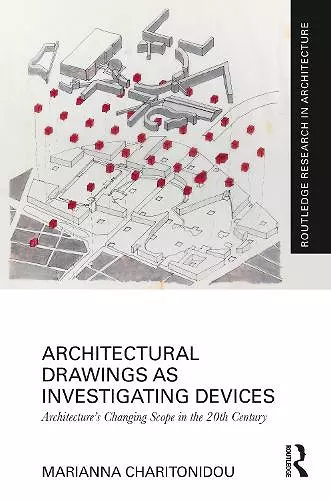Architectural Drawings as Investigating Devices
Architecture’s Changing Scope in the 20th Century
Format:Hardback
Publisher:Taylor & Francis Ltd
Published:10th Jul '23
Should be back in stock very soon
This hardback is available in another edition too:
- Paperback£39.99(9781032444185)

Architectural Drawings as Investigating Devices explores how the changing modes of representation in architecture and urbanism relate to the transformation of how the addressees of architecture and urbanism are conceived.
The book diagnoses the dominant epistemological debates in architecture and urbanism during the 20th and 21st centuries. It traces their transformations, paying special attention to Le Corbusier and Ludwig Mies van der Rohe’s preference for perspective representation, to the diagrams of Team 10 architects, to the critiques of functionalism, and the upgrade of the artefactual value of architectural drawings in Aldo Rossi, John Hejduk, Peter Eisenman, and Oswald Mathias Ungers, and, finally, to the reinvention of architectural programme through the event in Bernard Tschumi and the Office for Metropolitan Architecture (OMA). Particular emphasis is placed on the spirit of truth and clarity in modernist architecture, the relationship between the individual and the community in post-war era architecture, the decodification of design process as syntactic analogy and the paradigm of autonomy in the 1970s and 1980s architecture, the concern about the dynamic character of urban conditions and the potentialities hidden in architectural programme in the post-autonomy era.
This book is based on extensive archival research in Canada, the USA and Europe, and will be of interest to architects, artists, researchers and students in architecture, architectural history, theory, cultural theory, philosophy and aesthetics.
Boldly, Charitonidou's new book Architectural Drawings as Investigating Devices attempts to theorize the creative process itself by investigating the way luminary architects such as Corbusier, Mies van der Rohe, Aldo Rossi, Peter Eisenman, John Hejduk, Oswald Mathias Ungers, Bernard Tschumi and Rem Koolhaas produce their designs in conversation with the times. She argues that architectural drawings should be understood as dispositifs that function as virtual meetings points of the ideas of the designers, the needs of the eventual users of the buildings, and the desires of the developers funding the projects. In this way, she shows that the virtual is already material and a necessary part of and not just a preliminary to the actual. It is a rich and powerful book that will stimulate debate and thinking in the field of architecture for years to come.
Ian Buchanan, Professor of Cultural Studies, University of Wollongong, Australia
This book is an important contribution to our understanding of architectural design. Exploring the complex interplay of visual representation and architectural discourse, Marianna Charitonidou offers excellent and inspiring insight of how, over the last hundred years, leading Western architects used sketches and drawings as research and design tools, but also for shaping the roles of users and observers, and for architecture pedagogy.
Christian Gänshirt, Visiting Professor, Department of Architecture and Urban Studies, Politecnico di Milano
This book contributes to the contemporary transient and dynamic relationship between the work of architecture, the spectator, and the user. While the architect seemingly remains extraneous to the longevity and crisis of the triangle, Marianna Charitonidou’s retrospective agenda charts four generations of architects' contributions to the core idea of drawing, be it representational or abstract and diagrammatical. In each chapter, Architectural Drawings as an Investigating Devices provides a valuable discussion of the impact of socio-cultural and technological as it concerns the representation and reception of architecture. A timely reading as architecture departs from its past invisible ties with the city for a self-referential commodity form deserted in the megalopolis.
Gevork Hartoonian, Em. Professor of the history of architecture, University of Canberra, Australia
ISBN: 9781032431109
Dimensions: unknown
Weight: 760g
270 pages